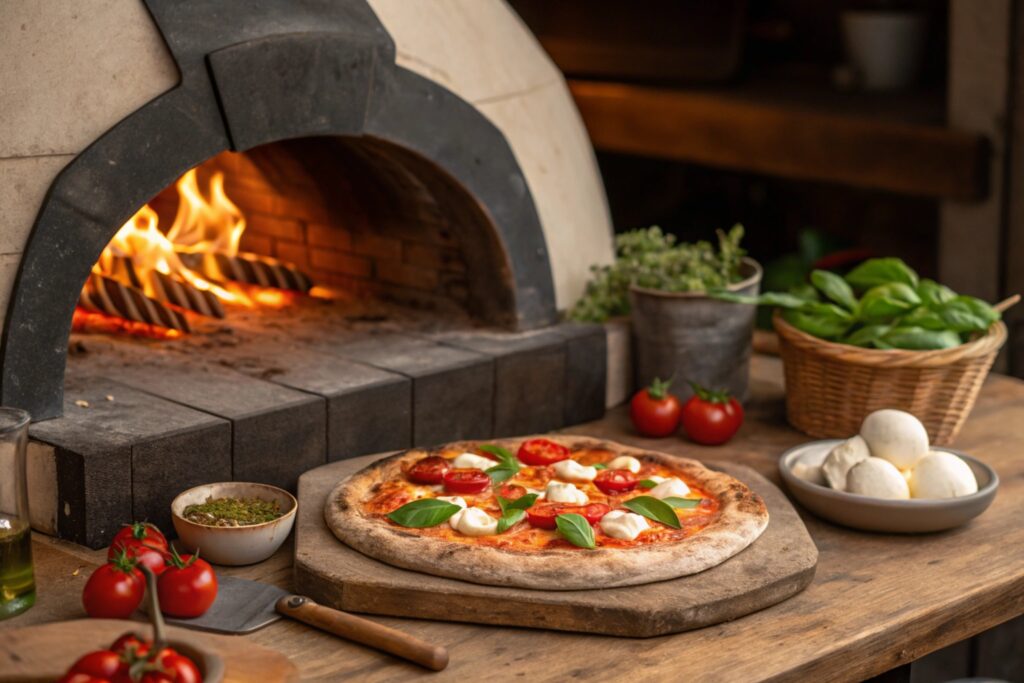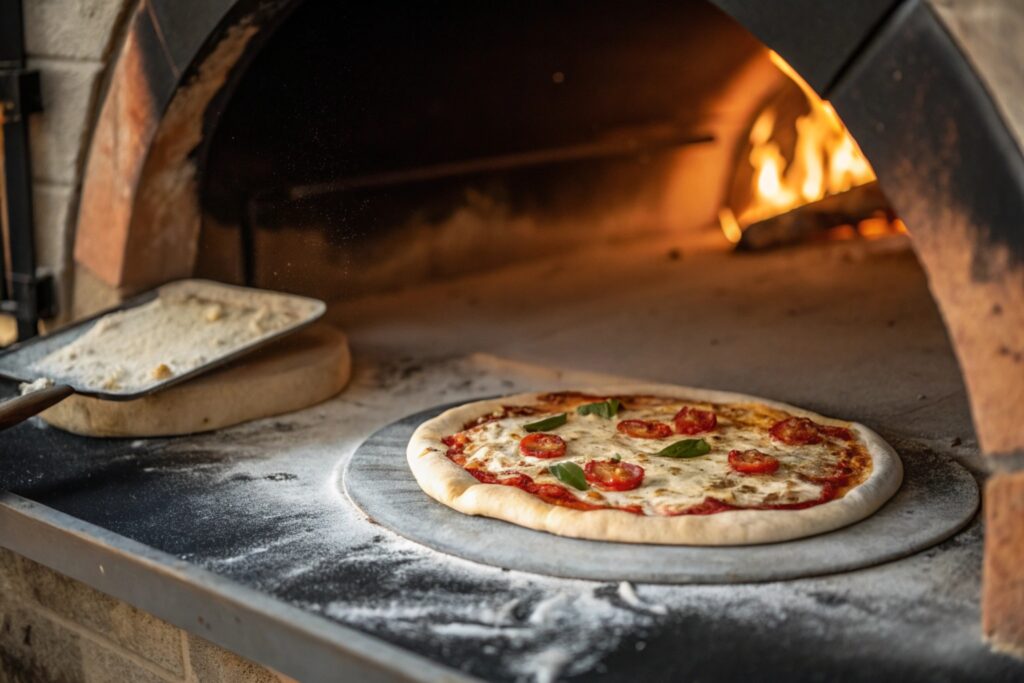
Table of Contents
1. Is Wood Oven Pizza Better?
When it comes to pizza, the debate between wood oven pizza and traditional oven pizza is a hot topic among enthusiasts. Each method has its unique characteristics, but many argue that wood oven pizza offers distinct advantages.
Flavor Profile Comparison
- Wood-Fired Flavor: Cooking pizza in a wood oven imparts a unique smoky flavor that is hard to replicate. The burning wood creates a high-temperature environment that caramelizes the dough and toppings, enhancing the overall taste.
- Traditional Oven Flavor: While traditional ovens can produce delicious pizza, they often lack the depth of flavor that comes from wood-fired cooking. The absence of smoke can make the pizza taste less complex.
Texture and Crust Quality
- Crispy Crust: Wood ovens reach higher temperatures (often exceeding 800°F), which allows for a quick bake. This results in a crispy crust with a chewy interior, a hallmark of authentic Neapolitan-style pizza.
- Traditional Oven Crust: Traditional ovens typically operate at lower temperatures, which can lead to a softer crust. While still enjoyable, it may not achieve the same level of crispiness as wood-fired pizza.
Cooking Time and Efficiency
- Speed of Cooking: Wood ovens can cook a pizza in as little as 90 seconds, thanks to the intense heat. This efficiency is ideal for busy pizzerias or home cooks who want to serve multiple pizzas quickly.
- Traditional Oven Cooking Time: In contrast, traditional ovens may take 10-15 minutes to cook a pizza, which can be a drawback for those looking to serve a crowd.
2. How to Cook Pizza in a Wood Oven?

Cooking pizza in a wood oven requires some preparation and technique. Here’s a step-by-step guide to help you achieve the best results.
Preparing the Oven
- Preheat the Oven: Start by lighting the wood and allowing the oven to reach the desired temperature. This can take anywhere from 30 minutes to an hour, depending on the oven’s design.
- Check the Temperature: Use an infrared thermometer to ensure the oven is at the right temperature (around 800°F for optimal cooking).
Pizza Assembly Techniques
- Dough Preparation: Use high-quality flour and allow the dough to ferment for at least 24 hours. This enhances flavor and texture.
- Stretching the Dough: Gently stretch the dough by hand to avoid deflating the air bubbles. Aim for a thin center with a slightly thicker edge for the crust.
- Topping Selection: Use fresh ingredients like mozzarella cheese, tomato sauce, and basil. Avoid overloading the pizza, as this can lead to sogginess.
Cooking Process
- Placing the Pizza: Use a pizza peel to transfer the pizza into the oven. Make sure the peel is dusted with flour to prevent sticking.
- Monitoring Cooking Time: Keep an eye on the pizza as it cooks. Rotate it halfway through to ensure even cooking.
- Finishing Touches: Once the crust is golden and the cheese is bubbly, remove the pizza from the oven and let it cool for a minute before slicing.
3. Is a Wood Burning Pizza Oven Worth It?
Investing in a wood-burning pizza oven can be a significant decision. Here are some factors to consider.
Cost Analysis
- Initial Investment: Wood ovens can range from a few hundred to several thousand dollars, depending on the model and materials used.
- Long-Term Benefits: While the upfront cost is high, the ability to cook restaurant-quality pizza at home can save money in the long run.
Versatility and Use Cases
- Beyond Pizza: A wood oven is not just for pizza. You can also cook bread, roast meats, and even bake desserts, making it a versatile addition to your outdoor cooking setup.
- Outdoor Cooking Experience: Cooking with a wood oven can enhance your outdoor gatherings, providing a unique experience for family and friends.
Maintenance and Upkeep
- Cleaning Requirements: Wood ovens require regular cleaning to remove ash and debris. However, this is a small price to pay for the delicious results.
- Durability: Many wood ovens are built to last, often made from materials like brick or stone that can withstand high temperatures.
4. Do I Need a Pizza Stone in a Wood Fired Oven?

Using a pizza stone in a wood-fired oven can significantly enhance your pizza-making experience. Here’s why you might consider it.
Benefits of Using a Pizza Stone
- Heat Retention: A pizza stone absorbs and retains heat, providing a consistent cooking surface. This helps achieve a crispy crust while preventing sogginess.
- Even Cooking: The stone distributes heat evenly, ensuring that the pizza cooks uniformly. This is especially important for thicker crusts or pizzas with multiple toppings.
Types of Pizza Stones
- Material Options: Pizza stones come in various materials, including ceramic, cordierite, and cast iron. Each has its pros and cons:
- Ceramic: Good heat retention but can crack under extreme temperature changes.
- Cordierite: Highly durable and can withstand high temperatures, making it a popular choice.
- Cast Iron: Excellent heat retention and can be used on the stovetop or in the oven.
- Size and Thickness: Choose a stone that fits your oven and is thick enough to withstand high heat without warping.
Usage Tips
- Preheating the Stone: Always preheat the pizza stone in the oven for at least 30 minutes before cooking. This ensures it reaches the right temperature for optimal cooking.
- Cleaning and Maintenance: Avoid using soap on your pizza stone, as it can absorb flavors. Instead, scrape off any residue with a spatula and wipe it down with a damp cloth.
5. What is the Best Floor for a Wood Fired Pizza Oven?
The floor of your wood-fired pizza oven plays a crucial role in cooking performance. Here’s what to consider.
Material Options
- Brick: Traditional choice for wood-fired ovens, providing excellent heat retention and durability.
- Stone: Natural stone can also be used, offering similar benefits to brick.
- Concrete: A more modern option, concrete can be effective but may require additional insulation to retain heat.
Heat Retention and Distribution
- Importance of Material: The material of the oven floor affects how well it retains and distributes heat. A well-constructed floor will help maintain high temperatures, essential for cooking pizza quickly and evenly.
- Impact on Cooking Performance: A good floor material will help achieve that perfect crispy crust while ensuring the toppings are cooked through.
Installation Considerations
- Safety and Durability: Ensure that the floor is installed correctly to withstand the high temperatures of a wood oven. Proper insulation is also crucial to prevent heat loss.
- Thickness and Structure: A thicker floor will generally provide better heat retention. Aim for a minimum thickness of 2-3 inches for optimal performance.
6. Does a Pizza Stone Really Make a Difference?
Many pizza enthusiasts swear by using a pizza stone, but is it really necessary? Let’s explore.
Heat Distribution
- Even Cooking: A pizza stone helps distribute heat evenly across the pizza, reducing the risk of hot spots that can lead to uneven cooking.
- Crispy Crust: The stone absorbs moisture from the dough, resulting in a crispier crust compared to cooking on a metal surface.
Moisture Absorption
- Impact on Crust Quality: A pizza stone’s ability to absorb moisture is crucial for achieving that perfect crust. It helps create a barrier that prevents the dough from becoming soggy.
- Comparison with Metal Surfaces: Cooking directly on a metal surface can lead to a softer crust, as metal does not absorb moisture in the same way.
User Experiences
- Testimonials: Many home cooks report a noticeable improvement in their pizza quality after using a pizza stone. The difference in texture and flavor can be significant.
- Common Misconceptions: Some believe that a pizza stone is unnecessary if using a wood oven, but it can enhance the cooking process and final product.
7. Conclusion
In the debate between wood oven pizza and traditional oven pizza, both methods have their merits. However, the choice ultimately depends on your preferences, cooking style, and the experience you seek.
Key Takeaways
- Flavor and Texture: Wood oven pizza offers a unique smoky flavor and a crispy crust that many pizza lovers crave. Traditional ovens can produce great pizza but may lack the depth of flavor.
- Cooking Efficiency: Wood ovens cook pizzas quickly, making them ideal for serving multiple guests. Traditional ovens take longer, which can be a consideration for larger gatherings.
- Investment and Versatility: While a wood-burning pizza oven requires a higher initial investment, its versatility allows for cooking a variety of dishes beyond pizza, enhancing your outdoor cooking experience.
If you’re interested in exploring how different cooking methods impact health, you might find our article on Is Indian Food Healthy? insightful. Additionally, for those considering the quality of ingredients, comparing homemade pizza to frozen options can be enlightening, as discussed in Healthy Choice Frozen Meals. Lastly, if you’re curious about other cooking techniques that enhance flavor, check out our guide on Smoker Recipes: Best Foods, Tips & Quick Ideas.
8. FAQs
Is wood oven pizza better?
Yes, many enthusiasts believe that wood oven pizza is superior due to its unique flavor, crispy crust, and quick cooking time. However, personal preference plays a significant role.
How to cook pizza in a wood oven?
- Preheat the oven to around 800°F.
- Prepare your dough and toppings.
- Use a pizza peel to transfer the pizza into the oven.
- Cook for about 90 seconds, rotating halfway through for even cooking.
Is a wood burning pizza oven worth it?
A wood-burning pizza oven can be worth the investment if you enjoy outdoor cooking and want to create restaurant-quality pizza at home. It also allows for versatility in cooking other dishes.
Do I need a pizza stone in a wood fired oven?
While not strictly necessary, a pizza stone can enhance your cooking by providing better heat retention and moisture absorption, resulting in a crispier crust.
What is the best floor for a wood fired pizza oven?
The best floor materials include brick and stone, as they provide excellent heat retention and durability. Ensure proper installation for optimal performance.
Does a pizza stone really make a difference?
Yes, a pizza stone can significantly improve the quality of your pizza by ensuring even cooking and a crispy crust. It absorbs moisture, preventing sogginess.
